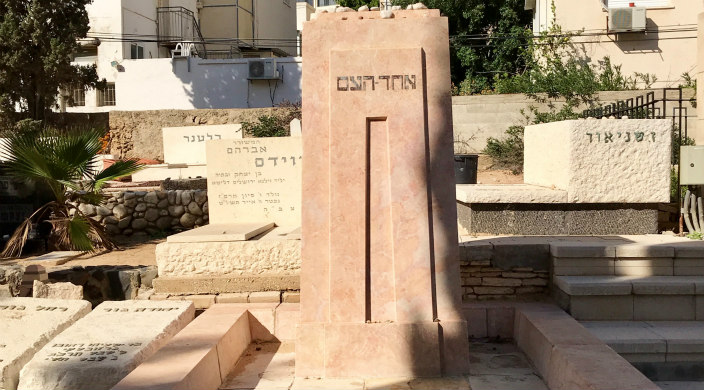
At the end of my most recent trip to Israel in December, I added on a few days for personal time and exploration in Tel Aviv. The weather was unseasonably warm, even for this Mediterranean city, so I explored by taking long walks. With time on my hands, I walked down side streets and let them lead me to unexpected places. During these walks, I stumbled upon sites I had forgotten about and discovered new pieces of Tel Aviv history, as well as reminders, from architectural and other clues, of the city’s ethnic and historical distinctions, that once were more pronounced.
On one such walk from my hotel near to the beach to Rabin Square in the center of Tel Aviv, I avoided a more direct route on a busier cross street by walking down Trumpledor Street. Amid low-rise residential and communal buildings, I came upon a walled-off compound that turned out to be what is known as the Old Cemetery. When opened in 1902, the cemetery – as is the custom with burial grounds – was put in an area that was far removed from where Jews lived in Jaffa and in the newer areas of settlement surrounding that port city,
In the cemetery, a school group was doing a history activity focused on some of the most famous early Zionist figures and subsequent Tel Aviv celebrities interred there – from the great Hebrew poet, Hayim Nahman Bialik (d.1934), to Israel’s most well-known painter, Reuven Rubin (d. 1974), to the pop star, Arik Einstein (d. 2013).
Amid the 5,000 graves are the known and not-so-well-known, the stones etched in a variety of Hebrew fonts expressing religious and literary allusions for honoring the departed. One, elegantly unadorned, rising above its neighbors in its sleek construction, caught my attention. Its simple inscription reads in Hebrew Ahad Ha’am, the pen name of Asher Ginsberg (1856-1927), one of the most influential pre-state Zionist thinkers, considered to be the founder of cultural Zionism. Honoring his literary name, which means “one of the people” (based on Genesis 26:10), his tombstone offers no other indication of who the man was who is buried there.
It’s his prescience as an observer of facts-on-the ground that I choose to honor here.
Before he settled in Palestine in 1921, for the remaining illness-ridden years of his life, Ahad Ha’am was a frequent traveler to the region to gather eye-witness information about Jewish settlement on behalf of early Zionist efforts in Europe. What he wrote about over a century ago has much to teach about the current tensions and issues that the almost 70-year-old State of Israel is dealing with today.
After his first trip to Palestine in 1891, he wrote a pamphlet entitled “Truth from the Land of Israel.” Notwithstanding the critical reception this publication received in some spheres, both for what he wrote and how he promoted himself, Ahad Ha’am must be recognized for having predicted the difficulties that Jews and Arabs would eventually encounter about sharing the land. In one particularly bold passage, Ahad Ha’am demonstrated his understanding, even at the end of the 19th century, that co-existence could be the only workable strategy for Jews to move to their ancestral homeland:
We who live abroad are accustomed to believe that almost all Eretz Yisrael is now uninhabited desert and whoever wishes can buy land there as he pleases. But this is not true. It is very difficult to find in the land [ha'aretz] cultivated fields that are not used for planting. Only those sand fields or stone mountains that would require the investment of hard labour and great expense to make them good for planting remain uncultivated and that’s because the Arabs do not like working too much in the present for a distant future... The Arabs, especially the urban elite, see and understand what we are doing and what we wish to do on the land, but they keep quiet and pretend not to notice anything. For now, they do not consider our actions as presenting a future danger to them. … But, if the time comes that our people’s life in Eretz Yisrael will develop to a point where we are taking their place, either slightly or significantly, the natives are not going to just step aside so easily.
Of course. Ahad Ha’am’s cautionary advice was only addressed to his fellow Zionists who were beginning to create the legal and political legitimacy for safe and secure Jewish life in the land. As the eventual unfolding of the uneasy relationship he foresaw would come about, the Arab side, too, would be called to account for its role in creating this conflict for which there is no optimistic end in view. Considering where we are in 2018, Ahad Ha’am’s 19th century “truth” claims that nationalistic mythologizing is an obstacle that obstructs the view of living side-by-side with “the other,” the kind of peace, I believe, most Israelis and Palestinians still dream about when they go to bed each night.




